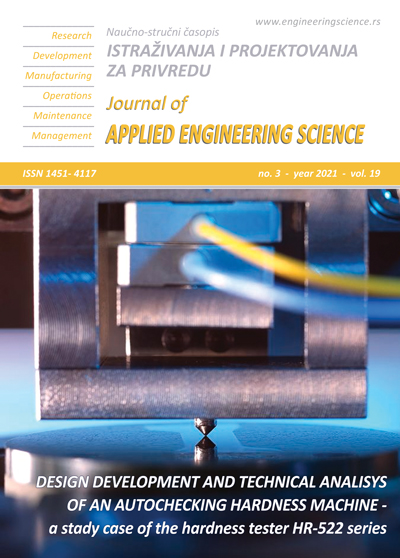OPTIMAL THERMAL SENSORS PLACEMENT BASED ON INDOOR THERMAL ENVIRONMENT CHARACTERIZATION BY USING CFD MODEL
Abstract
This paper discusses analysis to obtain the optimal thermal sensors placement based on indoor thermal characteristics. The method relies on the CFD simulation by manipulating the outdoor climate and indoor air conditioning (AC) system. First, the alternative sensor's position considered the optimum installation and the occupant's safety. Utilizing the Standardized Euclidean Distance analysis, these positions are then selected for the best position using the distribution of the thermal parameters' values data at the activity zones. On-site measurement validated the CFD model results with the maximum RMSE between both data sets as 0.76 °C for temperature, the relative humidity of 3.67, and an air velocity of 0.08 m/s2, due to the significant effect of the building location. The SED analysis results are the optimum sensor positions that accurately, consistently, and have the optimum % coverage representing the thermal condition at 1,1m floor level. The positions are B5 for R15, position D4 for R33, and position B6 for R40. At these positions, actual sensors are installed and proven to be valid results since sensors could detect thermal variables at the height of 1.1 m with SED validation values of 0.76 °C, 3.67, and dan 0.08 m/s2, for R15, R33, and R40, respectively.
References
H. Batih and C. Sorapipatana, "Characteristics of urban households' electrical energy consumption in Indonesia and its saving potentials," Renew. Sustain. Energy Rev., vol. 57, pp. 1160–1173, 2016.
ASHRAE Standard 55, Thermal environmental conditions for human occupancy. 2010.
P. Fanger, Thermal comfort: Analysis and Applications in Environmental Engineering. Danish Technical Press, 1970.
K. Parsons, Human Thermal Environments, Second edi. New York: Taylor & Francis, 2003.
M. J. Varas-Muriel, R. Fort, M. I. Martínez-Garrido, A. Zornoza-Indart, and P. López-Arce, "Fluctuations in the indoor environment in Spanish rural churches and their effects on heritage conservation: Hygro-thermal and CO2 conditions monitoring," Build. Environ., vol. 82, pp. 97–109, 2014.
W. Rattanongphisat, T. Prachaona, A. Harfield, K. Sato, and O. Hanaoka, "Indoor Climate Data Analysis Based a Monitoring Platform for Thermal Comfort Evaluation and Energy Conservation," Energy Procedia, vol. 138, pp. 211–216, 2017.
M. W. Ahmad, M. Mourshed, D. Mundow, M. Sisinni, and Y. Rezgui, "Building energy metering and environmental monitoring - A state-of-the-art review and directions for future research," Energy Build., vol. 120, pp. 85–102, 2016.
T. Seabrook, "Optimal Placement Strategies of Minimum Effective Sensors for Application in Smart Buildings."
H. Hayat et al., "The state-of-the-art of sensors and environmental monitoring technologies in buildings," Sensors (Switzerland), vol. 19, no. 17, 2019.
D. G. Eliades, M. P. Michaelides, C. G. Panayiotou, and M. M. Polycarpou, "Security-oriented sensor placement in intelligent buildings," Build. Environ., vol. 63, pp. 114–121, 2013.
H. Sharma, U. Vaidya, and B. Ganapathysubramanian, "A transfer operator methodology for optimal sensor placement accounting for uncertainty," Build. Environ., vol. 155, no. March, pp. 334–349, 2019.
J. Waeytens and S. Sadr, "Computer-aided placement of air quality sensors using adjoint framework and sensor features to localize indoor source emission," Build. Environ., vol. 144, no. August, pp. 184–193, 2018.
R. J. Yanti, Faridah, I. W. Mustika, D. D. Ariananda, and S. S. Utami, "Analysis of Gaussian process to predict thermal sensor placement for controlling energy consumption on the educational building," in AIP Conference Proceedings, 2020, vol. 2223.
S. Yeon Lee, I. bok Lee, U. Hyeon Yeo, R. woo Kim, and J. Gyu Kim, "Optimal sensor placement for monitoring and controlling greenhouse internal environments," Biosyst. Eng., vol. 188, pp. 190–206, 2019.
D. Yoganathan, S. Kondepudi, B. Kalluri, and S. Manthapuri, "Optimal sensor placement strategy for office buildings using clustering algorithms," Energy Build., vol. 158, pp. 1206–1225, 2018.
P. Erickson, M. Cline, N. Tirpankar, and T. Henderson, "Gaussian processes for multi-sensor environmental monitoring," IEEE Int. Conf. Multisens. Fusion Integr. Intell. Syst., vol. 2015-October, pp. 208–213, 2015.
M. Al-Kuwari, A. Ramadan, Y. Ismael, L. Al-Sughair, A. Gastli, and M. Benammar, "Smart-home automation using IoT-based sensing and monitoring platform," Proc. - 2018 IEEE 12th Int. Conf. Compat. Power Electron. Power Eng. CPE-POWERENG 2018, pp. 1–6, 2018.
P. Zhou, G. Huang, L. Zhang, and K. F. Tsang, "Wireless sensor network based monitoring system for a large-scale indoor space: Data process and supply air allocation optimization," Energy Build., vol. 103, pp. 365–374, 2015.
Y. Jin, Y. Xiong, L. Wang, Y. X. Liu, and Y. Zhang, "Eco-feedback for thermal comfort and cost efficiency in a nearly zero-energy residence in Guilin, China," Energy Build., vol. 173, pp. 1–10, 2018.
M. Greenacre and R. Primicerio, Multivariate Analysis of Ecological Data, Rubes Edit. Spain: Fundación BBVA, 2013.
R. Geiger, H. Aron, and P. Todhunter, The Climate Near the Ground, 5th ed. Harvard University Press, Cambridge, Mass, 1961.
A. Al-janabi, M. Kavgic, A. Mohammadzadeh, and A. Azzouz, "Comparison of EnergyPlus and IES to model a complex university building using three scenarios: Free-floating, ideal air load system, and detailed," J. Build. Eng., vol. 22, no. September 2018, pp. 262–280, 2019.
D. B. Crawley, J. W. Hand, M. Kummert, and B. T. Griffith, "Contrasting the capabilities of building energy performance simulation programs," Build. Environ., vol. 43, no. 4, pp. 661–673, 2008.
Jamal M Saleh, Fluid flow handbook. New York: McGraw-Hill, 2002.
Hugo Hens, Building Physics Heat, Air, and Moisture : Fundamentals and Engineering Methods with Examples and Exercices, Third. Germany: Wilhelm Ernst & Sohn, 2017.
T. R. Oke, G. Mills, A. Christen, and J. A. Voogt, Urban Climates. Cambridge University Press, 2017.
I. Kurniawan, Faridah, and S. S. Utami, "Characterizing of climate chamber thermal environment using the CFD simulation method using IES VE," in AIP Conference Proceedings, 2020, no. April.

